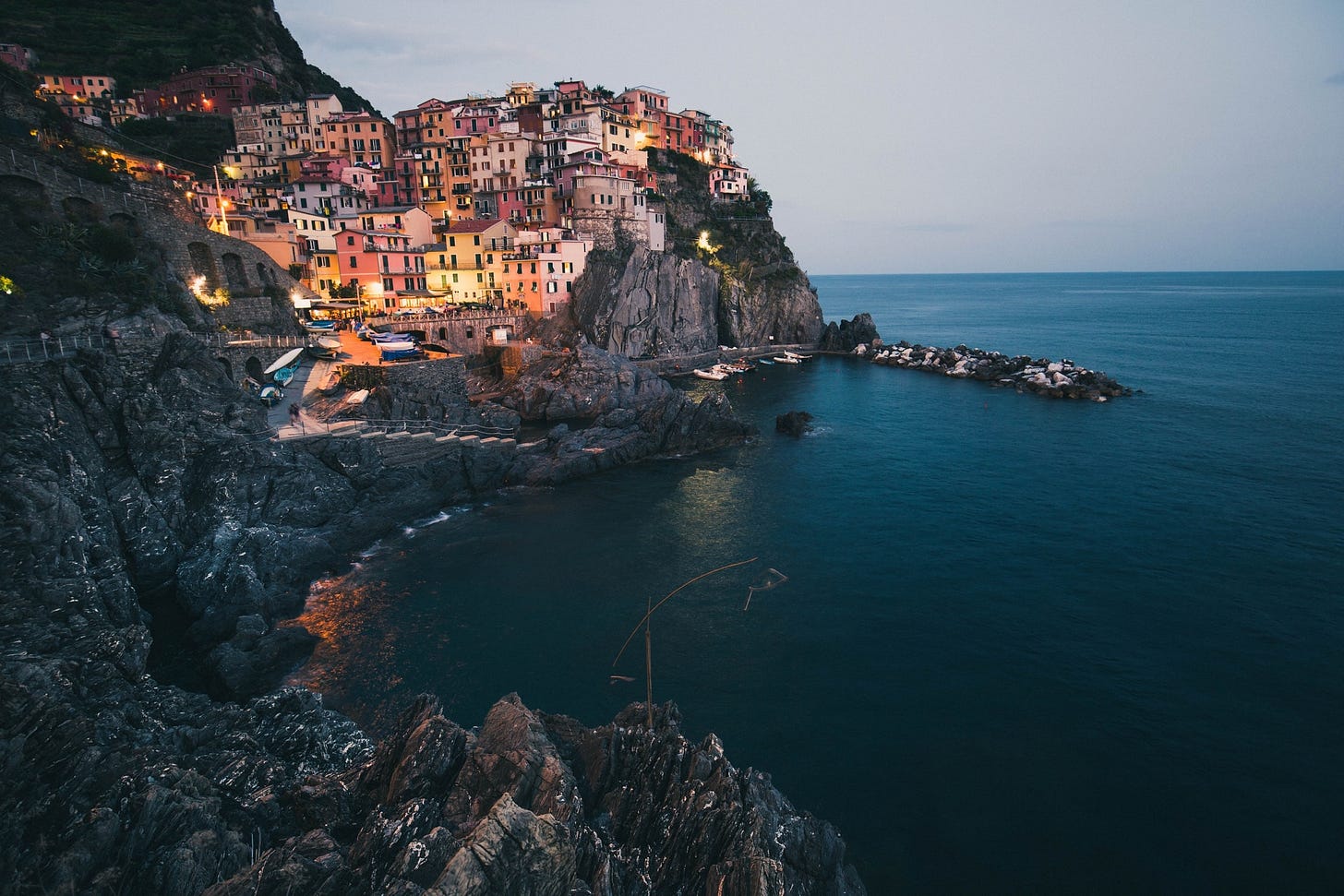There’s this game I discovered not too long ago called Townscaper.
Watch the video by the creator for an intro:

This humble game blows my mind 🤯
The plump sound design, the juicy colour palettes, the totally adorable buildings… 😍
As I’ve been collecting examples of decent fictional urbanism, I’m slowly coming to a realization that there is something that game, movie and theme park designers know about cities that people building modern cities somehow haven’t been able to harness.
It is the power of simple rules.
Simple rules is counter-intuitive because they may sound simple, but they have the power to create powerfully complex and emergent behaviours.
An example of simple rules in action: Rule of Thirds.
In composition, the rule of thirds is a grid that encourages you position your subject in an off-centre way, to remain in harmony with the rest of the picture.
Given the unlimited situations that artists can apply it, the collective body of work becomes very varied. They can take pictures of literally anything, as long as they try to apply the rule of third on a case-by-case basis. There is great room for interpretation.
Simple rules demonstrate another quality that often cannot easily be replicated…
It’s the quality of emergence.
Emergence can only -ahem- emerge when there are limits within a system that individual agents react to. For instance, to use the Rule of Thirds, the subjects must be placed in a way that somehow interacts with the grid, and especially the red circles.
Also, the images above are limited to being a rectangular picture.
Everyone will follow these rules, and adapt them to their own local conditions.
If we told people to ditch the grid, or introduced randomly shaped frames, the rule would lose its meaning and cease to have that emergent quality.
The quality of emergence comes from independent agents applying common rules to local conditions.
Prescriptive vs. Proscriptive rules, and their differences
About the same time when I discovered Christopher Alexander about 15 years ago, I also came across the work of Besim Hakim. His book on Mediterranean Urbanism is a study on the rules in place that led to the distinctive development pattern that we see in so many coastal towns facing the Mediterranean Sea.

In his research, he came across two types of rules.
Rules that demand you to do X. These are prescriptive rules and generally used to roll out things of top-down nature.
Example: Everyone must observe Summer Solstice as an official holiday.
Example: Everyone should wear hats tonight.
Rules that let you do anything except Y. These are proscriptive rules and generally suitable for adapting to local conditions.
Example: You can sit anywhere except on the seats that say Reserved.
Example: You can put a window anywhere as long as it doesn’t directly face another window within 12 metres.
Using the Rule of Thirds example above, the prescriptive rule is to place your subject so it interacts somehow with the grid - no exceptions. Also, only a rectangular format is allowed.
The proscriptive rule is that you can take a picture of anything, as long as there is enough in the picture that can be interpreted as a “subject”. No fully black or over-exposed images, or too abstract images that have no natural “centredness”.
Back to Townscaper…
Townscaper, the game, is simple-looking. However, every user interaction produces a result that is based on intersecting rules that are both prescriptive and proscriptive in nature. It is this intersecting nature of the prescriptive and proscriptive rules that produces wonderfully emergent townscape results - every time.
Prescriptive design aspects (global rules, world-oriented, top-down)
The town must follow the underlying cellular (and non-orthogonal) development pattern.
Clicking on the ocean shall create a platform structure.
The platform shall have enclosing balustrades.
Platform pieces that touch tangentially shall be connected via a walkway.
Clicking on a platform shall make a Building.
Buildings shall have a door facing the platform, and the front shall have something interesting on it (a plant, an apiary, binoculars, a bench)
Buildings shall have a pitched roof.
An enclosed block of buildings shall have a green courtyard in the middle with benches in them
An overhanging building shall be supported by metal structure and/or have an arc created under it
Two tall walls separated by one space shall produce one or more clothes-line… etc etc
Proscriptive design aspects (local rules, agent-oriented, bottom-up)
You can click anywhere as long as it is on the ocean, or on an existing structure (platform or building).
You choose the colour of the buildings you put down.
The result, with just a few clicks, is some pretty incredible-looking townscapes.

Why this matters for city building
Here’s a quote from Professor Hakim who is answering a question about the difference between ancient and contemporary city building practices (emphasis mine):
Since the early civilizations of Mesopotamia, Greece, Rome, Byzantine and Islamic, rules were developed that specifically addressed change and growth in the built environment as a natural phenomenon that was recognized and dealt with. Due to the nature of the compactness of traditional built environments, that were common in the territories of those civilizations, the rules addressed issues pertinent to compactness, and to the manner in which responsibilities were allocated among people and property owners whose decisions impacted the pattern of development and changes that might occur across time…
The ancient rules were in most situations proscriptive in nature, allowing flexibility and interpretation of application at the local level. Whereas modern rules are in most cases, and in most countries today, prescriptive top-down strict codes that are not responsive to local micro-conditions.
Modern city-building practices have largely scrapped the ancient, emergent ways of building cities in favour of zoning and other overly-prescriptive rules. To adapt our prescriptive rules to local context, our zoning codes grow more and more complicated requiring vast amounts of exceptions and administrative work every time someone wants to make a change to their property.
The administration of urban change has become an industry in and of itself, and urban planners are fully complicit in this hollow task.
And every time there’s another exception to the rule, the rule loses power and eventually stands for nothing.
It is ironic that North American cities don’t allow for more rule-based, emergent urban development. Real estate needs of the market could be addressed more dynamically and on an ad-hoc basis, compared to the current regime in Toronto and other places like San Francisco, which is too restricted by law to be market-driven.
I know I’m a day late! What started out as an ode to a cute town-building game grew into a real meaty piece on rule-based design.
Still, thanks for reading all the way till the end, hope you enjoyed it.
Give this letter a ❤️ if you enjoyed it (and do share the letter with friends who may appreciate it too!)
Until next time, stay safe and stay curious.
—Fei🪢




I love townscaper!! To me not only are the graphics beautiful, the soundscape is also amazing. It makes just the right *bloops* when new structures pop up.
Thanks for sharing! Love the prescriptive vs proscriptive rules. I have mostly proscriptive rules in the house with Jaime and her friends. The most important one is: you can be mindlessly scrolling on your phone except at the dining table and in the bedroom.
And promenadia looks cool!